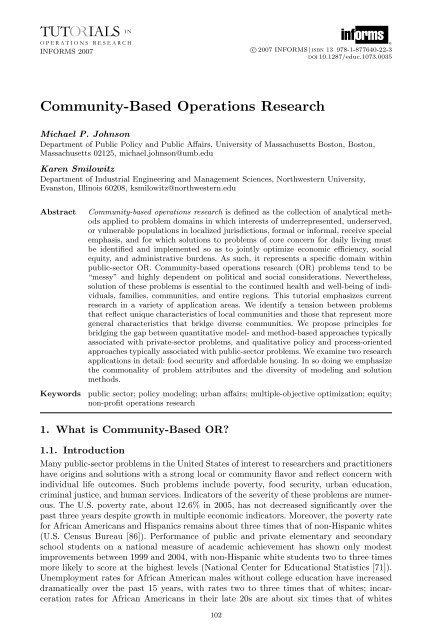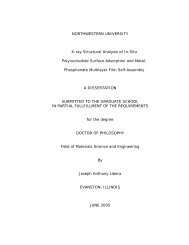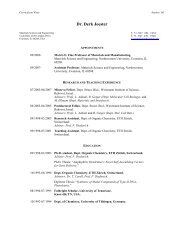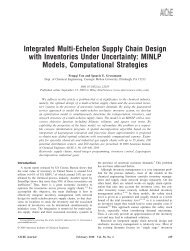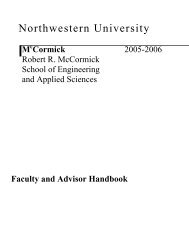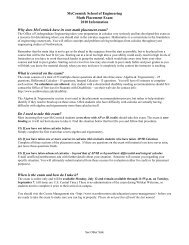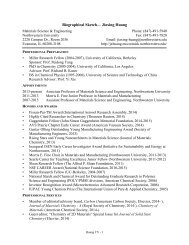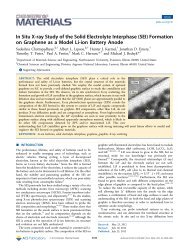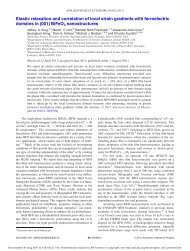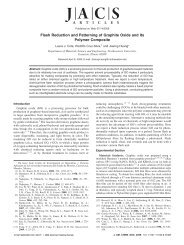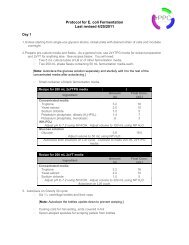Community-Based Operations Research - Humanitarian Logistics
Community-Based Operations Research - Humanitarian Logistics
Community-Based Operations Research - Humanitarian Logistics
Create successful ePaper yourself
Turn your PDF publications into a flip-book with our unique Google optimized e-Paper software.
INFORMS 2007 c○ 2007 INFORMS | isbn 13 978-1-877640-22-3doi 10.1287/educ.1073.0035<strong>Community</strong>-<strong>Based</strong> <strong>Operations</strong> <strong>Research</strong>Michael P. JohnsonDepartment of Public Policy and Public Affairs, University of Massachusetts Boston, Boston,Massachusetts 02125, michael.johnson@umb.eduKaren SmilowitzDepartment of Industrial Engineering and Management Sciences, Northwestern University,Evanston, Illinois 60208, ksmilowitz@northwestern.eduAbstractKeywords<strong>Community</strong>-based operations research is defined as the collection of analytical methodsapplied to problem domains in which interests of underrepresented, underserved,or vulnerable populations in localized jurisdictions, formal or informal, receive specialemphasis, and for which solutions to problems of core concern for daily living mustbe identified and implemented so as to jointly optimize economic efficiency, socialequity, and administrative burdens.As such, it represents a specific domain withinpublic-sector OR.<strong>Community</strong>-based operations research (OR) problems tend to be“messy” and highly dependent on political and social considerations.Nevertheless,solution of these problems is essential to the continued health and well-being of individuals,families, communities, and entire regions.This tutorial emphasizes currentresearch in a variety of application areas.We identify a tension between problemsthat reflect unique characteristics of local communities and those that represent moregeneral characteristics that bridge diverse communities.We propose principles forbridging the gap between quantitative model- and method-based approaches typicallyassociated with private-sector problems, and qualitative policy and process-orientedapproaches typically associated with public-sector problems.We examine two researchapplications in detail: food security and affordable housing.In so doing we emphasizethe commonality of problem attributes and the diversity of modeling and solutionmethods.public sector; policy modeling; urban affairs; multiple-objective optimization; equity;non-profit operations research1. What is <strong>Community</strong>-<strong>Based</strong> OR?1.1. IntroductionMany public-sector problems in the United States of interest to researchers and practitionershave origins and solutions with a strong local or community flavor and reflect concern withindividual life outcomes. Such problems include poverty, food security, urban education,criminal justice, and human services. Indicators of the severity of these problems are numerous.The U.S. poverty rate, about 12.6% in 2005, has not decreased significantly over thepast three years despite growth in multiple economic indicators. Moreover, the poverty ratefor African Americans and Hispanics remains about three times that of non-Hispanic whites(U.S. Census Bureau [86]). Performance of public and private elementary and secondaryschool students on a national measure of academic achievement has shown only modestimprovements between 1999 and 2004, with non-Hispanic white students two to three timesmore likely to score at the highest levels (National Center for Educational Statistics [71]).Unemployment rates for African American males without college education have increaseddramatically over the past 15 years, with rates two to three times that of whites; incarcerationrates for African Americans in their late 20s are about six times that of whites102
Johnson and Smilowitz: <strong>Community</strong>-<strong>Based</strong> <strong>Operations</strong> <strong>Research</strong>Tutorialsin <strong>Operations</strong><strong>Research</strong>, c○ 2007 INFORMS 103(Western [95], Bureau of Justice Statistics [17]). The number of U.S. households with atleast moderate housing burdens (at least 30% of income) rose from 31to 34 million between2001and 2004, whereas average commute times increased at greater rates for lower-incomefamilies than for higher-income families (Joint Center for Housing Studies [47]).<strong>Research</strong> on social issues such as those described above has traditionally been descriptivein nature, and concentrated within the social sciences, urban planning, and relateddisciplines; they have tended to receive somewhat less attention from disciplines such asoperations research/management science (OR/MS) whose models and methods tend to bemore prescriptive. We assert that an adaptation of previously identified domains of OR/MS,which we denote as community-based operations research, is well positioned to provide modelsand analytic methods that can provide guidance to individuals, government, and nongovernmentalorganizations that seek to address these problems. In this tutorial, we describethe characteristics of problems that fall within the scope of community-based OR, developa taxonomy of problem areas, provide a review of related OR/MS research literature, andexplore two case studies of community-based OR applications. Finally, we identify somenext steps for research and practice in this area.The scope of this tutorial is largely limited to the U.S., as American political and socialvalues, and demographic and economic characteristics may differ from other developed countriesin certain ways relevant to community-based OR. We focus on the last 30 or so years ofresearch and applications, the scope of time within which “public-sector operations research”has become a well-defined domain. We define OR/MS broadly to include prescriptive decisionmodels as well as descriptive models that are directly applicable to decision modeling.Evidence to support the presence of community-based OR comes primarily from refereedjournal articles, published books, and conference proceedings, although working papers arecited if they provide primary evidence of recent research activity in a given domain.1.2. Defining <strong>Community</strong>-<strong>Based</strong> ORFundamentally, community-based OR addresses public-sector problems, that is, problemsin which the primary outcome measure to be optimized is not a direct representation—orproxy for—shareholder benefit and in which the outputs are subject to public scrutiny (see,e.g., Pollock and Maltz [75], p. 6). <strong>Community</strong>-based OR is a subfield of public-sector OR(see e.g., Pollock et al. [76], Larson and Odoni [60]), which emphasizes most strongly theneeds and concerns of disadvantaged human stakeholders in well-defined neighborhoods.Within these neighborhoods, localized characteristics vary over space and exert a stronginfluence over relevant analytic models and policy or operational prescriptions. There arethree important implications of this definition that distinguish community-based OR fromother areas of public-sector OR.First, our focus on human stakeholders implies a fundamental interest in human versusphysical resources, as might be represented by decision models for natural resources management,energy policy, and—to a lesser extent—infrastructure design. Second, our focus on disadvantaged,underserved, or vulnerable populations recognizes that these groups may havedistinct social or political preferences, are less able to use political influence to adapt publicpolicies to their own needs, and may suffer stigma that may impede access to resources,expertise and tools associated with state-of-the art decision models or policy interventions.Third, our focus on “place” implies that models should account for community-level characteristics,like socio-economic status, that are salient to decision models and which vary overspace in systematic ways. For example, suppose a public-library-branch location model doesnot distinguish between demands originating from neighborhoods that differ according tosocio-economic status. Then a poor and nonpoor neighborhood with equal levels of demandmay be treated equally by the model, even if relative travel costs are higher and marginalbenefits from access to recreational and educational resources greater for residents of poorneighborhoods as compared to nonpoor neighborhoods.
Johnson and Smilowitz: <strong>Community</strong>-<strong>Based</strong> <strong>Operations</strong> <strong>Research</strong>104 Tutorialsin <strong>Operations</strong><strong>Research</strong>, c○ 2007 INFORMS<strong>Community</strong>-based OR has its roots in a classic article by Ackoff [2] describing community-engagedproblem solving in a distressed, mostly African American community inPhiladelphia. This amalgam of analysis, action, and advocacy received the greatest attentionin the United Kingdom during the 1980s and 1990s as community operational research(Jackson [37], Parry and Mingers [73], Taket and White [83]), although some attention hasbeen given to this sort of OR practice and theory in the U.S. (e.g., Bajgier et al. [5]). Animportant goal of this tutorial is to respond to Parry and Mingers’ statement that “verylittle has been published on <strong>Community</strong> OR, and as a result it is unclear how much asbeen achieved” ([73], p. 580). These authors demonstrated that much of the work in communityOR appeared to consist of student projects and community outreach that mightbe classified now as “capacity-building,” rather than applications based on analytic modelsintended to provide specific policy and operational guidance to decision makers in a waythat extends existing theory and methods. Most of the applications of community-based ORdescribed in this tutorial have occurred since Parry and Mingers’ [73] article, and addressthe methodological concerns noted above.Certain public-sector problems are not amenable to community-based OR. As mentionedpreviously, many social problems, such as criminal offending, low-quality housing, or inadequateaccess to retail food outlets exhibit symptoms that vary across neighborhoods. Theseproblems may also have important regional or national characteristics that are aggregates ofindividual outcomes, for example high incarceration rates, residential segregation, or adversehealth outcomes related to food insecurity. In turn, these high-level characteristics may beassociated with regional or national-level policy failures, such as ineffective national drugenforcement policy, inadequate funding for affordable housing, or insufficient incentives forgrocery stores to locate in underserved communities. An important area of public-sectorOR, referred to by Kaplan [52] as policy modeling, uses stylized models inspired by problemsof a local nature that may generate important insights regarding regional or national-levelpolicy design. Policy modeling has yielded novel and influential insights in drug policy (seee.g., Rydell et al. [79]), crime policy (see e.g., Blumstein et al. [12]), and public health (seee.g., Kaplan and Merson [55]). <strong>Community</strong>-based OR, although quite distinct from policymodeling, can complement policy modeling by generating solutions associated with directand rapid improvements in individual and neighborhood-level outcomes.We may summarize the defining characteristics of community-based OR problems as follows.They tend to have multiple stakeholders and multiple decision makers (Gass [26],Bardach [8]). We enumerate typical stakeholder and/or decision-maker groups as follows.Donors are government, nonprofit, or for-profit organizations whose direct or in-kind contributionssupport service provision. Clients are individuals, families, or organizations whobenefit directly from service provision. Nonclient residents are individuals, families, or organizationswho benefit indirectly or not at all from service provision but who may neverthelesspay for it through taxes. Service providers are government or non-profit organizations whodesign, implement, and manage service provision strategies. Local government enforces laws,administrative rules, and codes that define the legality of various initiatives. As we haveemphasized, key stakeholders and decision makers are localized and often economically orsocially disadvantaged. Therefore, trade-offs between efficiency, effectiveness, and equity areessential. In contrast to other private- and public-sector OR models, limiting focus to a singledecision maker, stakeholder, or objective function type may obscure important aspectsof the problem at hand.As for United Kingdom-style community OR, successful community-based OR modelsand applications require substantial stakeholder participation in problem definition, solution,and implementation (Bajgier et al. [5], Taket and White [83]). This is incompatible with theconventional “consultant” view of OR modeling in which a dispassionate expert becomesimmersed in a problem domain, formulates and solves an appropriate analytical model, andpresents a range of recommendations to decision makers.
Johnson and Smilowitz: <strong>Community</strong>-<strong>Based</strong> <strong>Operations</strong> <strong>Research</strong>Tutorialsin <strong>Operations</strong><strong>Research</strong>, c○ 2007 INFORMS 105Accountability, a traditional focus of public administration generally (Heinrich [35]; seealso Gates [27]) is especially important for community-based OR for determining the socialimpact of model solutions. Many important community-based services, targeted as they areon disadvantaged populations, generate relatively low levels of user fees and rely disproportionatelyon support from nongovernmental organizations. In turn, these donors maywant service providers to demonstrate that they have achieved significant client and systemoutcomes—but these are difficult to measure and communicate, as compared to process outputs.The implications of this criterion are twofold: There is an increased need for researchersto design effectiveness measures that can be easily implemented in community OR models,and there is an increased need for practitioners to work closely with funders to justify thesupport received.Finally, there is a general tension between uniqueness and generalizeability that affectshow community-based OR models and applications are viewed by disciplines that mighttake an interest in them. The greater the programmatic and spatial specificity of a givenapplication and the focus given to community engagement, the greater is the resemblanceof community-based OR to domains at the intersection of community planning, communityorganizing, and social work. As Kaplan [52] observes, this view of community-based ORmay have led Ackoff [3] to become disenchanted with the prospects of “traditional” OR as avehicle for making significant changes in society. The greater the generality of the model andthe application, the greater is the resemblance of community-based OR to decision modelingapplications whose contribution is primarily technical and methodological, or those, likepolicy modeling, that take a regional or national focus, decreasing the likelihood of direct,relatively rapid benefits to community stakeholders. Our belief is that, all else equal, thelong-term impact of community-based OR is likely to be greatest if emphasis is placed onmodels that provide specific, theory-based guidance to local decision makers that can beeasily replicated in different application contexts.1.3. Sample Application: Public-School System DesignAn example of an application that captures many of the characteristics of community-basedOR described above is that of an urban public-school district facing declining enrollment,increasingly rigorous educational quality targets and revenue shortfalls that must simultaneouslydecide on a set of schools to close and to combine, academic programs to relocate, andstudents to reassign (see e.g., Mar Molinero [64], and Johnson [41]). Table 1 demonstratesthe various dimensions along which community-based OR can help decision makers andstakeholders collaborate to generate specific recommendations for policy and operationalguidance.Results indicate that this problem is rich, in terms of opportunities for community engagement,mathematical modeling complexity, data requirements, and multi-stakeholder decisionsupport. A traditional OR approach to this application might emphasize sophisticated,high-quality solution algorithms for a somewhat stylized representation of the underlyingproblem, perhaps using simulated data, and a focus on efficiency and possibly effectivenessmeasures. A community-based OR approach might instead result in a model that capturesthe local environment more fully, and incorporate equity and effectiveness explicitly, thusimplying greater difficulty in optimal solution procedures. However, this approach might alsoresult in heuristic solution algorithms and strategies for model formulation and policy implementationthat emphasize qualitative methods more typical of UK-style community OR.1.4. A Taxonomy of <strong>Community</strong>-<strong>Based</strong> OR ApplicationsThere is no concise, standard classification of public-sector service areas known to us (a comprehensivelist of service areas is available on the U.S. Blue Pages, http://www.usbluepages.gov). For the purposes of this tutorial, we classify community-based OR application areas
Johnson and Smilowitz: <strong>Community</strong>-<strong>Based</strong> <strong>Operations</strong> <strong>Research</strong>106 Tutorialsin <strong>Operations</strong><strong>Research</strong>, c○ 2007 INFORMSTable 1.Example community-based OR application: Urban public-school closings.AttributeDescriptionLocalized focusMultiple conflictingobjectivesMultiple stakeholdersRole of disadvantageAccountabilityLack of resourcesUniqueness versusgeneralizeabilityNote. Problem description: Johnson [41].A school-closing policy may differentially affect low-performing schools,and disadvantaged neighborhoods, as compared to schools andneighborhoods overall.Therefore, generic modeling constructs may notcapture the most challenging aspects of urban public-education policy.Efficiency: direct dollar savings in fixed and variable costsEffectiveness: changes in student educational performanceEquity: changes in average school travel times across neighborhoods;changes in levels of racial, ethnic or class segregation across andwithin schools.Donors: local school district, federal government, local foundations.Clients: families whose children attend public schools.Nonclient residents: households without school-age children, or whosechildren attend nonpublic schools.Service provider: local board of education.Racial and ethnic minorities, who tend to be economicallydisadvantaged and segregated, may constitute a majority of studentsenrolled in public schools, although not necessarily a majority of thevoting population, or cadre of professional analysts, funders, or politicalleaders.Cost savings are a direct consequence of school closings; improvededucational outcomes are not.Educational outcomes may even worsenover the short term as the system re-equilibrates.School-closing decisions could be based, in part, on conventionalmeasures such as standardized test scores—or, alternatively, on moresophisticated measures that identify the “value added” by schools.Butspecifying the latter might be controversial and expensive.Local boards of education may have no analysts with experience inOR/MS models and methods, and few hardware or software resourcesto solve the challenging models that arise in developing school-closingstrategies.Too much focus on local attributes shifts emphasis to politics, communityorganizing, and educational administration rather than a more genericmodel that can incorporate issues relevant to many different cities.in four broad categories: human services, community development, public health and safety,and nonprofit management. Human services consist of services to senior citizens, humanitarian(e.g., post-disaster) logistics, public libraries and literacy, public education, and familysupportive services. Family supportive services include e.g., foster care, income-based benefitssuch as food stamps and public assistance, and need-based benefits such as mentalhealth/mental retardation, drug/alcohol treatment, and homeless services.<strong>Community</strong> development consists of housing, community/urban planning, and transportation.In turn, housing can be classified as low- and moderate-income housing, often providedthrough government subsidies, and affordable, mixed-income, and workforce housing, oftenprovided through zoning ordinances or private initiative as well as direct government support.<strong>Community</strong> and urban planning can address conventional economic developmentof distressed or isolated communities as well as pre-disaster planning and post-disasterreconstruction.Public health and safety addresses health care, criminal justice, emergency services, hazardous/undesirablefacility location, and the correlation of chronic diseases and individualdeprivation or social externalities, such as food insecurity or proximity to environmental
Johnson and Smilowitz: <strong>Community</strong>-<strong>Based</strong> <strong>Operations</strong> <strong>Research</strong>Tutorialsin <strong>Operations</strong><strong>Research</strong>, c○ 2007 INFORMS 107hazards. Finally, nonprofit management addresses general issues in management of community-basedor community-oriented service providers. In §2 we will review selected researchliterature in these broad application areas.Table 2 displays a variety of community-based OR application areas according to multipleattributes such as geographic/temporal scope, performance/outcome metrics, and modeling/computationalcomplexity. If there are multiple examples of published OR applicationsin a particular category, we emphasize the application we believe has the strongest communityorientation.Note that community-based OR problems can be operational, tactical, or strategic innature; that analytical methods from logistics and multicriteria decision-analysis/decisiontheory tend to dominate, and that there are multiple outcome measures of interest, someof which may require knowledge of economics to quantify (e.g., net social benefit), others ofwhich may require close examination of stakeholder values (e.g., equity).1.5. What is <strong>Community</strong>-<strong>Based</strong> OR’s Profile Within the Profession?We conclude this introductory section by assessing the visibility of community-based ORwithin the OR/MS community. <strong>Community</strong>-based OR appears to have a low profile withintop-tier disciplinary OR/MS journals. A review of articles published between 2002 and2007 whose topics appear consistent with our definition of community-based OR yields fourpapers in <strong>Operations</strong> <strong>Research</strong> out of 401, 1 or 1%, and no papers in Management Science,Transportation Science, orInformation Systems Review.<strong>Community</strong>-based OR also appears to have a low profile within academic degree programsthat intersect OR/MS. A scan of curricula of top schools, according to the 2007 rankings ofU.S. News and World Report [90, 91], indicates that within the top 25 undergraduate industrialengineering/operations research programs, none appears to offer courses that addresscommunity-based OR; within the top 10 graduate industrial engineering/operations researchprograms, only one offers one or more courses whose content includes community-based OR.Within the top 25 undergraduate business programs, only one appears to offer one or morecourses that address community-based OR; a similar result holds for the top 25 graduateprograms in business. Finally, within the top 25 graduate programs in public affairs, onlythree offer courses with significant OR/MS content, and of these only one school’s OR/MScourse offerings appear to address community-based OR.We acknowledge that much important work in OR/MS that intersects community-basedOR is done outside of business schools, departments of industrial engineering and remainsunpublished, or is published in non-OR/MS flagship journals. For example, pro bono ORconsulting and applications, as advocated by Woolsey [97] and McCardle [66], often addressproblems of interest to public-sector organizations. However, we believe that a greateremphasis on community-based OR in education, research, and practice may increase theprofessional returns to those who work in this area. We make specific suggestions in thisregard in the final section.2. Literature ReviewIn the years since the Parry and Mingers (1991) survey of community OR, a number ofpapers have appeared that address their concerns. In the review that follows, we focus onstudies in OR/MS and related fields that address analytic methods, public or nonprofitmanagement, localized needs, equity concerns, or disadvantaged/underserved populationswith a bias toward model-based prescriptions.1 Three of these papers appeared in a special 50th anniversary edition of <strong>Operations</strong> <strong>Research</strong> comprised ofspecially commissioned retrospectives.
Johnson and Smilowitz: <strong>Community</strong>-<strong>Based</strong> <strong>Operations</strong> <strong>Research</strong>108 Tutorialsin <strong>Operations</strong><strong>Research</strong>, c○ 2007 INFORMSTable 2.<strong>Community</strong>-based OR application areas.AttributesModeling/Application Example Geographic/ Performance/ computational Political/social Exampleareas application(s) Entity temporal scope outcome metrics Relevant methods complexity controversy applicationFood security Distribution of donatedfood from warehouseto local pantriesSeniorservices<strong>Humanitarian</strong>logisticsAffordable/subsidizedhousingPubliceducationDesign and locationof site-basedsenior services(meals-on-wheels,recreational facilities)Location of staging areasfor post-disasterdelivery of supplies;routing and schedulingof supply shipmentsLocation of “project-based”housing; potentialallocationsofhouseholds using“tenant-based” subsidies;decision support forindividual householdrelocationOpening/closing/resizing/reconfiguring buildingsand services; demandforecasting; performanceevaluation; studenttransportationGovernment, Regional; strategic/NGO ∗ tactical/operationalGovernment,NGOGovernment,NGOGovernment,NGO,publicprivatepartnershipsRegional; strategic/tactical/operationalNation, region;strategic/tactical/operationalRegion,neighborhood,individual;strategic/tactical/operationalGovernment Region; strategic/tactical/operationalPercentage foodoutlet needsmet; resourceutilizationTotal cost;percentage ofdemandsmetTotal cost,livessavedNet socialbenefit;percentage ofdemand met;equityNet socialbenefit;percentage ofdemand met;equityVehicle routing,inventory theoryLocation-allocation,vehicle routingLocation-allocation,vehicle routing,inventory theoryLocation-allocation;cost-benefitanalysis;multi-criteriadecision modelsLocation-allocation;forecasting; dataenvelopmentanalysis;districting; vehicleroutingHigh Low Lien et al.[61]Moderate to high Moderate Johnson et al.[46]High Moderate Campbellet al. [18]Moderate High Johnson [39]High High Mar Molinero[64]continued
Johnson and Smilowitz: <strong>Community</strong>-<strong>Based</strong> <strong>Operations</strong> <strong>Research</strong>Tutorialsin <strong>Operations</strong><strong>Research</strong>, c○ 2007 INFORMS 109Table 2.ContinuedAttributesModeling/Application Example Geographic/ Performance/ computational Political/social Exampleareas application(s) Entity temporal scope outcome metrics Relevant methods complexity controversy applicationCriminaljusticeUrban andregionaldevelopmentLocation of communitycorrectionscenters;facilitating prisonerre-entry intocommunitiesPost-disasterreconstruction;design of communityredevelopmentinitiatives; site selectionand parcel acquisitionPublic health Location/service design ofhealth centers; blooddistribution; design ofpublic health initiativesPubliclibraries/literacyUndesirablefacilitylocationEmergencyservicesGovernment,NGOGovernment,NGO,publicprivatepartnershipsGovernment,NGORegion,neighborhood;tacticalRegion,neighborhood;strategic/tacticalRegion,neighborhood,individual;strategic/tactical/operationalLocation/service design Government Region,neighborhood;strategic/tactical/operationalWaste dumps, powerplants, human servicesLocation of fire, policeand EMS stations;dispatching,routing and staffingGovernment,NGORegion,neighborhood;strategic/tacticalGovernment Regional,neighborhood;strategic/tactical/operationalNet social benefit;equityNet socialbenefit; equity;sustainability;spatialdesirabilityNet social benefit,equity, livessavedSocial cost,physical accessNet social benefit,equityTotal cost, livessaved, crimeaverted, equityLocation-allocation;forecastingLocation-allocation;districting;project selection;multi-criteriadecision models;decision analysisLocation-allocation;vehicle routing;inventory theory;stochasticprocesses;decision theoryLocation-allocation,schedulingLocation-allocation,multi-criteriadecision modelsLocation-allocation,queueing theory,decision theory,vehicle routingModerate High Johnson[40]High High Patz et al.[74]High High Kaplan [52]Moderate Low Mandell [63]Moderate High Murrayet al. [70]High High Bodily [13]∗ NGO = Nongovernmental organizations, e.g., community development organizations, social service agencies, churches.
Johnson and Smilowitz: <strong>Community</strong>-<strong>Based</strong> <strong>Operations</strong> <strong>Research</strong>110 Tutorialsin <strong>Operations</strong><strong>Research</strong>, c○ 2007 INFORMS2.1. Analytic Methods2.1.1. Quantitative Methods. We know of no conventional quantitative modelingmethods from OR/MS that cannot be applied to community-based OR problems. We drawattention to Erlenkotter’s [23] examination of an extension of the uncapacitated fixed-chargefacility location models to account for price-sensitive demands. He shows that a conventionalprivate-sector objective of profit maximization is equivalent to marginal-cost pricing,whereas a public-sector objective of total social benefit maximization yields revenues thatdo not cover total costs. A “quasi-public” variant of this problem ensures nonnegative profits.This analysis reinforces our emphasis on community-based OR models that attempt tojointly optimize measures of equity and social welfare. The latter objective, moreover, isgenerally not equivalent to profit maximization.2.1.2. Qualitative Methods. Qualitative methods provide a valuable complement totraditional approaches. UK-style community OR draws heavily from methods such as “softsystems methodology” (see e.g., Checkland [19]) that focus on systems analysis and qualitativemethods for learning about the problem. <strong>Community</strong>-based OR, in addition, accommodatesmethods such as “value-focused thinking” (Keeney [56]) that assists modelers informulating decision problems that are closely aligned with stakeholder values and amenableto analytical methods that yield specific prescriptions.2.2. Human Services2.2.1. Senior Services. Bartholdi et al. [9] develop a heuristic vehicle-routing strategyfor home-delivered meals (HDM, i.e., meals on wheels) that can be easily implementedby the resource-constrained organization using earlier work on space-filling curves. Wongand Meyer [96] use geographic information systems (GIS) to locate HDM kitchens anddesign delivery routes to minimize total travel distance. Gorr et al. [28] develop an interactive,optimization-based spatial decision support system (SDSS) for HDM kitchen location,catchment area design, and vehicle routing for the needs of nonprofit managers seekingincremental or dramatic changes to service strategies. Johnson et al. [46] design and implementhierarchical facility location models to locate facilities that provide daytime congregateservices to senior citizens that minimize distance-based costs and maximize utility usingcurrent local data on senior centers and demands for services.2.2.2. <strong>Humanitarian</strong> <strong>Logistics</strong>. Haghani and Oh [34] consider operational transportationproblems for a fixed distribution network and develop a model of the distributionprocess. Jia et al. [38] introduce network design models for large-scale emergency medicalservice in response to terrorist attacks. Balcik and Beamon [7] study distribution networkdesign for relief chains managed by nongovernmental organizations. Campbell et al. [18]explore various objective functions for the local distribution of supplies after a disaster. Toensure equity and efficiency, two objectives are considered: minimizing the maximum arrivalof supplies and minimizing the average arrival of supplies. Beamon and Kotleba [10] designa stochastic inventory control model that determines optimal order quantities and reorderpoints for a long-term emergency relief response.2.2.3. Public Libraries and Literacy. Mandell [63] presents multiple models of equityand effectiveness, and applies them to the problem of book acquisition for public libraries.Francis et al. [25] develop models to assist a large suburban library system to manageits vehicle fleet and optimize operations under budget constraints. The objective functionbalances travel time incurred by the delivery agency and the service benefit to the librariesserved. A similar, smaller interlibrary loan system in Ohio, studied in Min [68], differs fromthe current example in that all libraries are visited daily.
Johnson and Smilowitz: <strong>Community</strong>-<strong>Based</strong> <strong>Operations</strong> <strong>Research</strong>Tutorialsin <strong>Operations</strong><strong>Research</strong>, c○ 2007 INFORMS 1112.2.4. Public Education. Thanassoulis and Dunstan [85] show how data envelopmentanalysis (DEA) can be used to guide secondary schools to improved performance throughrole-model identification and target setting in a way that recognizes the multioutcome natureof the education process and reflects the relative desirability of improving individual outcomes.The approach presented in the paper draws from a DEA-based assessment of theschools of a local education authority carried out by the authors. Mar Molinero [64] developsrecommendations for school closures in a region with declining school-age population usingtechniques to measure the similarity of school catchment areas that are input to a multidimensionalscaling analysis that identifies socio-economic characteristics of these areas.Recommendations to close high-cost, low-performing schools that serve most-disadvantagedregions are contrasted with political opposition from local communities that seek to preservelocal educational opportunities. Bowerman [14] formulates a multiobjective modelfor urban school-bus routing that addresses efficiency and equity jointly, and develops atwo-phase approach combining student clustering and route generation. Taylor et al. [84]describe forecasting models for school attendance and optimization models for public-schoollocations and attendance boundaries, which reflect detailed knowledge of school administrators,elected representatives, and planners. These models address the need for racialbalance across schools to minimize the need for busing, and have increased the confidence ofcommunity stakeholders in the school planning process, as measured by decreased politicalopposition to siting plans and increased passage rate of funding referenda.2.3. <strong>Community</strong> Development2.3.1. Housing. Kaplan [49], Kaplan and Amir [53], and Kaplan and Berman [54] formulateand solve math programs related to production-scheduling problems to design policiesfor relocating families in public-housing communities undergoing renovations to minimizetotal development time while ensuring that as few families as possible are displaced frompublic housing into private markets. Kaplan [50] uses queuing theory to evaluate the impactsof race-based versus nonrace-based tenant-assignment policies in public housing on levels ofracial segregation and waiting times for available units. Forgionne [24] describes a decisionsupportsystem for assessing the army’s needs for on-base new construction or off-base leasedhousing, determined in part by estimates of the level of off-base affordable housing availableto its personnel.Johnson and Hurter [45] generate alternative potential allocations of households usingrental vouchers to Census tracts across a county to jointly optimize measures of net socialbenefit and equity, subject to constraints on programmatic and political feasibility. Estimatesof dollar-valued impacts of subsidized housing are derived from models adapted fromhousing economics that use observations of actual households. Johnson [43] solves a multiobjectivemodel for location of project-based affordable renter- and owner-occupied housing tooptimize social efficiency and equity measures. Objective functions and structural parametervalues are derived from discussions with nonprofit housing providers. Johnson [44] estimatesstructural parameters for math programming-based models for affordable housing designusing microeconomic models of the firm and of the consumer, and statistical methods suchas forecasting and factor analysis. Observations of housing units, households, and housingprojects are provided by community-based nonprofit housing developers.Johnson [39] presents a Web-accessible prototype of a SDSS for individual housing mobilitycounseling using multiple decision models and reflecting the needs of housing clients,counselors, and landlords. Johnson [42] provides a research framework for a professionalqualityhousing counseling SDSS and provides evidence derived from field research thattypical subsidized housing program participants can make productive use of quantitativedecision models. Both of these papers are discussed in greater detail in §3.
Johnson and Smilowitz: <strong>Community</strong>-<strong>Based</strong> <strong>Operations</strong> <strong>Research</strong>112 Tutorialsin <strong>Operations</strong><strong>Research</strong>, c○ 2007 INFORMS2.3.2. <strong>Community</strong>/Urban Planning. Norman and Norman [72] evaluate case studiesof public art installations in Japan and the UK to support the concept of centralized, modelbaseddecision making in the provision of public amenities. Patz et al. [74] develop decisionmodels to design land-use strategies in a European context, allowing especially for existinghistoric buildings and districts. Jung et al. [48] develop a planning model for post-disasterreconstruction planning in urban areas inspired by Hurricane Katrina, which struck theU.S. Gulf Coast in 2005. In this model, small neighborhoods are aggregated into districtsthat share the same land-use designation (e.g., human use or passive use) in order to jointlyoptimize measures of environmental protection, social impacts, and spatial integrity.2.3.3. Transportation. Vlahos et al. [93] develop a framework for computer-aided transportationplanning that accommodates multiple, possibly antagonistic, stakeholders forthe purposes of presentation, analysis, and judgment. A case study of this methodologyemphasizes how community-based participants can collaborate with government and electedofficials in developing a controversial transportation strategy. Murray and Davis [69] usecommunity-level data on socio-economic status, public transport access, and public transportneed to determine differential impacts on communities of alternative public transitinvestments.2.4. Public Health and Safety2.4.1. Public Health. Kaplan [51] estimates changes in HIV-infection rates associatedwith an experimental needle-exchange program using maximum likelihood change-pointmodels and continuous-time Markov processes. Both models are estimated using observationsof the HIV status of used needles provided by injection drug users. Aaby et al. [1]present models to improve pre-contagion planning for clinics that dispense medications andvaccines using discrete-event simulations, queuing models, and capacity planning models.Griffin et al. [32, 33] have developed a decision model based on the maximum covering facilitylocation problem to identify centroids of U.S. counties at which community health centers(CHC) may be sited in order to maximize the weighted demand for CHC services, subjectto constraints on funds available for fixed and variable costs and facility capacities. Theirmodel qualifies as “community-based” in two ways: first, the care with which they haveanalyzed available health-care data to impute localized measures of health services demand,especially for medically underserved populations, and second, evidence provided that recommendationsare fairly insensitive to smaller spatial units of analysis such as Census tracts.They find significant improvements in a variety of performance measures, including totalencounters, cost per encounter, and number of uninsured persons served.Models to address food insecurity include Chou and Zheng [20] and Lien et al. [61]. Chouand Zheng study a bread delivery problem where unsold bread from bakeries is deliveredby volunteers to needy families. In their problem, demands are fixed and supply is random.They show how incorporating flexibility, meaning allowing volunteers to deliver to multiplefamilies, can reduce the amount of wasted bread. Lien, Iravani, and Smilowitz developmathematical models and solution methods for perishable food distribution from donorsto agencies that address vehicle-routing problems (assigning donors and agencies to routesand sequencing stops within each route) and inventory-allocation problems (determining theamount to distribute to each agency). In contrast to cost-minimizing objectives, which canlead to inequitable solutions, a novel service-based maximin fill-rate objective incorporatesfairness and agency sustainability, albeit at the cost of more complex modeling and solutiontechniques. This latter paper is discussed in greater detail in §3.2.4.2. CriminalJustice. Brown and Liu [16] develop crime forecasts to support tacticaloperations, in particular the presence and intensity of local “hot spots” using a multivariateprediction model that relates the features in an area to the predicted occurrence of
Johnson and Smilowitz: <strong>Community</strong>-<strong>Based</strong> <strong>Operations</strong> <strong>Research</strong>Tutorialsin <strong>Operations</strong><strong>Research</strong>, c○ 2007 INFORMS 113crimes through the preference structure of criminals. Xu and Chen [98] use link analysistechniques based on shortest-path algorithms to identify networks of offenders in areas suchas narcotics violation, terrorism, and kidnapping and find differing levels of effectivenessdepending on the shortest-path search strategy. Johnson [40] develops decision models toselect sites for community correction centers using multiobjective math programming andmulticriteria decision analysis. These models reflect field research with stakeholders and proposesiting strategies that account for neighborhood-level amenities that may be associatedwith successful re-entry to civilian life as well as concerns regarding potential re-offending.Blumstein [11] offers a comprehensive review of OR/MS applications to law enforcement andcriminology, focused on policy modeling but reflecting close examination of community-leveldynamics that motivate more stylized analytical approaches.2.4.3. Emergency Services. The literature on fire and emergency medical services provisionis extensive and long-lived; Swersey [82] provides a comprehensive review. Modelsfor location of emergency services facilities (e.g., Walker [94], Marianov and ReVelle [65],Hogan and ReVelle [36]) and end-user applications (RAND Fire Project [77]) are innovativein applying set covering models, maximum covering models, and backup coverage models,they typically do not address community-level or equity issues explicitly. However, Schillinget al. [81] formulated a multiple-objective maximum-covering-based model for fire-stationlocation that balances population coverage, property value coverage, and area coverage,i.e., the equity/efficiency/effectiveness objectives defined as key to community-based ORapplications. The police-sector-design problem, in which a study area is partitioned intoregions with equal service characteristics, has been dominated by queuing models such asthe Larson’s [58], [59] hypercube model. Bodily [13] applied multiattribute utility theoryto the hypercube model to incorporate preferences of citizens interested in service equity,police officers interested in workload equalization, and administrators interested in systemefficiency.2.4.4. Hazardous/Undesirable Facilities. The process by which undesirable, obnoxiousor hazardous facilities are located, and prescriptive models for doing so, contain elementsof commonality with community-based OR. Kleindorfer and Kunreuther [57] provide a comprehensiveoverview of this domain and describe a detailed process for facility siting thatincorporates community concerns. Gregory et al. [31] present policies by which communitystakeholders can be fairly compensated for accepting location of undesirable facilities.There are a variety of mathematical programming-based models for hazardous facilitysiting in which local community concerns and equity objectives are central. Ratick andWhite [78] formulate a model that balances measures of facility-location costs, politicalopposition as a function of the population within a risk radius of a facility, and equity, anincreasing function of the number of communities perceived by any particular communityas bearing equivalent risks associated with proximity to a facility. Erkut and Newman [22]extend the scale opposition factor within the model of Ratick and White by representingequity as a continuous (rather than discrete) function that increases in the distance betweenpopulation centers, as well as decreasing in facility size. Murray et al. [70] choose locationsfor undesirable facilities to maximize the total population that is outside the “impact radius”of sited facilities, or, in a variant, maximize the total weighted population that is within theimpact radius of at most one facility.Merkhofer and Keeney [67] use decision theory to choose sites for a nuclear-waste repositorywhile addressing community concerns, whereas Erkut and Moran [21] apply AnalyticHierarchy Process for location of municipal landfills, explicitly addressing a wide range ofcommunity-level factors that influence final rankings.
Johnson and Smilowitz: <strong>Community</strong>-<strong>Based</strong> <strong>Operations</strong> <strong>Research</strong>114 Tutorialsin <strong>Operations</strong><strong>Research</strong>, c○ 2007 INFORMS2.5. Nonprofit ManagementBaker Werth [6] describes the development of a decision-support division within a countyhuman-services agency to support strategic management and accountability services forlocal government. Vericourt and Lobo [92] model of a nonprofit’s decision to partake infor-profit activities. For-profit activities often generate future revenue for nonprofit workat the expense of current resources. They show that under certain conditions the optimalinvestment decision in for-profit activities is of threshold type.2.6. Lessons LearnedThe past 15 years has seen a significant growth in research that is consistent with ourdefinition of community-based OR. Increasingly, OR/MS researchers are aware of the needto incorporate socio-economic and political concerns directly into their planning models,rather than assert, as Gregg et al. [30] do in a stochastic programming model of facilitylocation applied to library closings, that “political factors can be incorporated by meansof user intervention” (p. 90). The models discussed in this section also reflect a desire toapply detailed understanding of stakeholder needs to quantitative models, which can yieldactionable, policy-relevant prescriptions. These efforts stand in contrast to some researchoutputs associated with UK-style community OR and early U.S. efforts in this domainthat focused more on community engagement and community efficacy. Finally, many of themodels discussed in this section cross disciplinary boundaries, for example adapting modelsfrom other domains for purposes of decision making, or using research evidence outside ofOR/MS to justify model-building efforts. However, more needs to be done to ensure thatnovel and innovative community-focused planning models are implemented in the field andtheir impacts on stakeholder groups evaluated rigorously. In this sense, the record of realworldimpacts represented by models of the type presented in Larson and Odoni’s Urban<strong>Operations</strong> <strong>Research</strong> [60] serve as a benchmark for community-based OR.3. Applications3.1. Food SecurityIn 2005, thirty-six million Americans suffered from hunger (U.S. Department of Agriculture[87]). Twenty-five million of these Americans rely on America’s Second Harvest (ASH)and their network of pantries, shelters, and soup kitchens for food (ASH [4]). The largestsuppliers to these agencies are regional and local food banks. Food banks are large-scaledistribution centers that collect, store, and distribute food. Much of this food is donatedby various sources of surplus food (e.g., supermarkets and grocery chains). According tothe U.S. Department of Agriculture [88], about 96 billion pounds of food are wasted eachyear in the United States. The goal of ASH and the agencies in their network is to matchsurplus food with those in need. This matching is a large-scale distribution and inventorymanagementproblem that occurs each day at thousands of nonprofit agencies across thecountry. Much research has been conducted on related supply-chain problems in commercialsettings where the goal of such systems is either to maximize profit or minimize cost. Littlework, however, has been conducted in nonprofit applications. In such settings, the objectivesare often more difficult to quantify because issues such as equity and sustainability must beconsidered, yet efficient operations are still crucial.The Greater Chicago Food Depository (GCFD) is an active ASH member. Accordingto a recent study by the GCFD and ASH [29], 500,000 people in the Chicago region areserved by the GCFD each year. One program run by the GCFD is the Food Rescue Program(FRP), which distributes perishable food from donors (e.g., supermarkets and restaurants)to agencies (e.g., shelters and soup kitchens). Over 80 donors and 100 agencies participatein the FRP, which moves over four million pounds of food annually.
Johnson and Smilowitz: <strong>Community</strong>-<strong>Based</strong> <strong>Operations</strong> <strong>Research</strong>Tutorialsin <strong>Operations</strong><strong>Research</strong>, c○ 2007 INFORMS 115Figure 1. Food rescue program sample routes.Lutheran Social Services of Illinois BHS DetoxCornerstone St. ThomasJesus PeopleLou Malnati’sC.H.I.C Red LobsterSuper targetRicobene’sGCFDJewelHighland day careJewelJewelJewelSt. SabinaJewelWhole fold ministriesRoute1:DonorAgencyCollectionDeliveryReturnRoute2:DonorAgencyCollectionDeliveryReturnJewelJewelJewelRestoration ministriesThe FRP operates five truck routes, each visiting between three and 17 donors andbetween two and 11 agencies daily. Two sample routes are shown in Figure 1. Routes beginat the depot, collect food from the donors, and distribute donations to the agencies. Thefrequency of visits to a location over the course of a month depends on the supply of thedonor and the need of the agency. Routes are scheduled weeks in advance and remain fairlyregular to facilitate driver familiarity with the routes they perform. Donation amounts andfood demand are unknown until observed on the driver’s arrival. The donation amountsdepend on daily sales at the donor location; food demands depend on available storage andbudget at the agencies. Drivers collect the full donation available at a donor. The allocationof food to agencies is left to the discretion of the driver who tries to satisfy an agency’sdemand while reserving supply for the remaining agencies on the route. Agencies are charged4 cents per pound of food and view the FRP as a supplement to their main food acquisitionoperations.Ongoing work (Lien et al. [61]) has focused on the design of inventory and routing policiesfor the FRP. The aim of this project is to develop mathematical models and solutionmethods for related vehicle-routing problems (assigning donors and agencies to routes andsequencing stops within each route) and inventory-allocation problems (determining theamount to distribute to each agency). In the private sector, related sequential inventoryallocationdecisions are often made to either maximize revenue or minimize costs. Althoughcost-efficient operations remain desirable in the nonprofit sector, focusing purely on costcan lead to inequitable solutions. The GCFD seeks to provide all agencies with adequateresources in an equitable manner. The paper proposes an alternative service-based objectivefunction (maximizing the minimum expected fill rate) that incorporates fairness and agencysustainability.The use of an alternative objective function has important implications on the solutionmethods used to determine routing and inventory-allocation policies. The authors findthat the useful mathematical properties of commercial distribution problems with profitmaximizingor cost-minimizing objectives (e.g., as in the multiperiod news-vendor problem)do not hold with the service-based objectives. As a result, new solution methods must bedeveloped. The paper also proposes simple routing and inventory-allocation policies thatperform well relative to more computer-intensive methods.3.2. Affordable/Subsidized HousingAs of 2000, about 10% of the poor population in the U.S. lives in high-poverty neighborhoods(Census tracts with poverty rates of 40% or greater). An overall decrease in concentrated
Johnson and Smilowitz: <strong>Community</strong>-<strong>Based</strong> <strong>Operations</strong> <strong>Research</strong>116 Tutorialsin <strong>Operations</strong><strong>Research</strong>, c○ 2007 INFORMSpoverty between 1990 and 2000 has been accompanied by stagnant or increasing levels ofpoverty concentration in the Northeastern and Western regions of the U.S., and increasingnumbers of poor families living in communities far away from the centers of America’scities (Joint Center for Housing Studies of Harvard University [47]). Housing mobility, i.e.,relocation of low-income families from distressed communities to more affluent, opportunityrichcommunities, has been one goal of affordable and subsidized housing policy.The Moving to Opportunity Program for Fair Housing (MTO), a national demonstrationintended to evaluate outcomes of housing mobility-program participants, offers the possibilityof significant improvements in living conditions and life outcomes for very low-incomefamilies who relocate using subsidies from the Housing Choice Voucher Program (HCVP).Over 6,000 families have participated in the experiment to date. Such areas for improvementsin life outcomes include: risk of criminal victimization, housing quality, and mentalhealth (U.S. Department of Housing and Urban Development [89]). MTO and HCVP isthe inspiration for development of a prototype spatial decision-support system (SDSS) forhousing-mobility counseling that might enable programs like MTO to be implemented ona large scale. This SDSS, called the Pittsburgh Housing eCounselor (http://www.housingecounselor.org)(Johnson [39]) is intended to assist housing counselors, clients, and landlordsin connecting low-income families to good-quality housing in opportunity-rich neighborhoods.This research confronts a number of gaps in current knowledge. First, there is littleresearch on the actual decision-making process by which housing mobility program participants(or HCVP clients) search for housing. Second, the extent to which public housingauthorities and other housing service agencies can assist creative decision making by clientswho may face multiple life challenges is limited by a lack of technical knowledge on informationtechnology (IT)-assisted decision making and the necessary IT infrastructure. Last,little is known about the ability of low-income families to frame and solve difficult problemsusing decision models and IT.The Pittsburgh Housing eCounselor guides users through the process of identifying candidatehousing units and neighborhoods, and ranking these candidate sites with two alternativemulticriteria decision models (MCDM). The eCounselor uses Keeney’s [56] value-focusedthinking method to enable clients and counselors together to identify characteristics of housingunits and neighborhoods that are important to the client and generate a subset ofhousing units and/or neighborhoods based on user-defined criteria. This process is representedby Figure 2, in which users start the search by identifying candidate neighborhoodsor, alternatively, candidate housing units, through appropriate queries and rank candidatedestinations using MCDM. Given these candidates for relocation, users choose acceptablehousing units or, alternatively, neighborhoods, thus creating a set of acceptable housingunits in acceptable neighborhoods suitable for site visits.Neighborhood characteristics are represented with spatial data describing demographic,employment, and housing characteristics of Allegheny County, PA and displayed in a Webbrowser. Figure 3 shows an example of this spatial data display, for fair housing complaintsin Allegheny County.Housing unit characteristics are represented with tabular data describing actual housingunits available for rent in the city of Pittsburgh and displayed in a Web browser similarly.Neighborhoods or housing units can be ranked using one of two MCDMs: eliminationby aspects (i.e., simple sort), in which users rank candidates in ascending order accordingto attribute values, or PROMETHEE (Brans and Vincke [15]), in which users specify theform of preference functions that measure the extent of a users’ preference for one alternativeover another with respect to the difference in performance of any pair of alternativesaccording to a single attribute. For example, a user could specify an increasing preferencefor one alternative over another as a linear function of the difference in crime rates of twoneighborhoods.
Johnson and Smilowitz: <strong>Community</strong>-<strong>Based</strong> <strong>Operations</strong> <strong>Research</strong>Tutorialsin <strong>Operations</strong><strong>Research</strong>, c○ 2007 INFORMS 117Figure 2. Counseling support system destination search algorithm.Housing unit first:Neighborhood first:Select desirable rental units from databaseSelect desirable neighborhoods via spatial analysisNoContinue?YesContinue?YesNoRank rental units using MCDMNoContinue?YesSelect desirable neighborhoods via spatial analysisRank neighborhoods using MCDMContinue?YesNoSelect desirable rental units from databaseRank neighborhoods using MCDMDelete rental units not in desirable neighborhoods(Re-) rank rental units, using “neighborhoodpreference” as an additional attributePrint list/stopFigure 3. Search Pittsburgh neighborhoods—fair housing complaints.
Johnson and Smilowitz: <strong>Community</strong>-<strong>Based</strong> <strong>Operations</strong> <strong>Research</strong>118 Tutorialsin <strong>Operations</strong><strong>Research</strong>, c○ 2007 INFORMSThe SDSS project has motivated subsequent field research to better understand theability of typical clients to make use of various MCDMs (Johnson [42]). A sample ofeight housing-voucher clients of a local public-housing authority used a custom applicationto rank hypothetical neighborhoods using three MCDMs: simple additive weightingusing rank sum weights (Malczewski [62], p. 199), Analytic Hierarchy Process (AHP; Saaty[80]), and PROMETHEE. We found that representative assisted-housing clients appear toappreciate the increased insight provided by more analytically demanding MCDMs suchas PROMETHEE, and that neighborhood rankings were largely dissimilar across the threeMCDMs. Thus, this research is supportive of the notion of model-based decision methodsas a tool for improving housing counseling, and provides suggestive evidence that a rangeof MCDMs may allow clients to choose the application that is best suited to their skills andpreferences.3.3. DiscussionThese case studies have demonstrated the potential of diverse methods in OR/MS to addressimportant problems of a local nature whose solutions may provide direct benefits to traditionallyunderserved or underrepresented populations. Equity is addressed in the fooddistribution application through an objective function that accommodates the needs of asmany food pantries as possible; the housing relocation SDSS incorporates equity by allowingclients themselves to define criteria and alternatives consistent with their own preferences,while enlarging their choice sets to the greatest extent possible. Although the two applicationsare inspired by region-specific policy problems, the solution methods may be appliedto many other regions. Finally, both applications reflect a concern with the ability of localorganizations to implement the models’ recommendations: the food distribution model usesheuristic solution methods and the housing relocation SDSS has a user interface that guidesclients’ interactions with decision models.4. ConclusionIn this chapter we have described a subfield of public-sector OR called community-basedoperations research that addresses topics of interest to researchers and practitioners for over30 years and is known to different audiences in the U.S. and UK under a variety of names.Common in our definition of community-based OR is a localized focus, a high degree ofambiguity, complexity, and controversy, and an emphasis on stakeholder groups that aretraditionally underrepresented or underserved by social and political systems of interest tothe modeler. Also, we emphasize the need for modelers to combine a focus on inclusion ofindividual actors and community-based organizations in defining and solving the problem(the traditional focus of UK-style “community OR”) with an emphasis on quantitativemodels that generate actionable and policy-relevant recommendations. We have providedcase studies in food security and affordable/subsidized housing that are consistent with thevarious components of the definition above.<strong>Based</strong> on our review of the research literature and resources within higher education, webelieve there is an opportunity to increase the influence of community-based OR on education,scholarship, and practice. Most importantly, we advocate an increase in the numberof courses in undergraduate and graduate programs in business administration, industrialengineering/operations research, and public affairs that address special characteristics ofnonprofit and government organizations and the decision problems they face. These coursesshould not be limited to project or capstone courses that have nonprofit organizationsas clients, but theory-based lecture courses as well. These courses should provide: greateremphasis on cross-disciplinary evidence to support OR/MS modeling, multidisciplinary solutionapproaches that emphasize less complex and/or qualitative solution methods, fieldresearch to generate realistic problem instances, and low-cost IT platforms for model and
Johnson and Smilowitz: <strong>Community</strong>-<strong>Based</strong> <strong>Operations</strong> <strong>Research</strong>Tutorialsin <strong>Operations</strong><strong>Research</strong>, c○ 2007 INFORMS 119service delivery. Such courses could leverage the considerable teaching resources associatedwith spreadsheet-based management science rather than specialized mathematical modelingapplications.Also, we recommend that professional societies increase the returns to community-basedOR research and practice. This could be done by encouraging workshops and conferencesessions devoted to community-based OR, greater awareness within the profession of publicpolicy/equity implications of models and applications, more support for cross-disciplinaryresearch that provides an evidentiary basis for community-based OR models, and increasedemphasis on international public-sector applications of community-based OR.There are many potential application areas for community-based OR. These include:location of businesses and services in low-income, especially urban and predominately minoritycommunities, such as financial services for the unbanked; decision-support systems forsystem-level redesign for mass transit, public schools, and senior services; and communityrevitalization through reuse of vacant lots and abandoned buildings. Finally, given theubiquity of the Internet, and recent decreases in the “digital divide” across race, ethnic,and income categories, there are opportunities for community-focused individual decisionapplications that use the Internet as a facilitator. Examples of these applications includeidentifying health and financial impacts of alternative food purchase strategies, especiallyfor low-income families, behavior change for energy reduction, and matching needs andlocations of low- and moderate-income families seeking family-support services with serviceproviders.AcknowledgmentsThe authors thank Louis Luangkesorn at RAND Corporation, for initial inspiration toexplore this domain in a formal way, and Janet Hunziker at the National Academy of Engineeringfor providing opportunities to explore this area more deeply. They also thank PhilipAkol, Robert Lien, and Patrick Mallory for their research assistance and Mark Daskin, EdKaplan, and Julie Swann for valuable literature references. This tutorial benefited greatlyfrom the comments of Al Blumstein, two anonymous reviewers, and the editor of this volume.This work was supported in part by the National Science Foundation Faculty Early CareerDevelopment (CAREER) Program, (CAREER: Public-Sector Decision Modeling for FacilityLocation and Service Delivery (Michael Johnson) and CAREER: Strategies to ImproveGoods Movement: Operational Choice in Routing (Karen Smilowitz)).References[1] K.Aaby, J.W.Herrmann, C.S.Jordan, M.Treadwell, and K.Wood.Montgomery county’s(Maryland) public health service uses operations research to plan emergency mass dispensingand vaccination clinics. Interfaces 36(6):569–579, 2006.[2] R.L.Ackoff.A black ghetto’s research on a university.<strong>Operations</strong> <strong>Research</strong> 18:761–771, 1970.[3] R.L.Ackoff.The future of operational research is past.Journal of the Operational <strong>Research</strong>Society 30:93–104, 1979.[4] America’s Second Harvest.Face of hunger in your community.http://www.secondharvest.org/who we help/hunger facts.html, 2005.[5] S.M.Bajgier, H.D.Maragah, M.S.Saccucci, A.Verzilli, and V.R.Prybutok.Introducingstudents to community operations research by using a city neighborhood as a living laboratory.<strong>Operations</strong> <strong>Research</strong> 39(5):701–709, 1991.[6] J.Baker Werth.Getting to the bottom line in local government: How San Diego county’shealth and human services agency uses decision support techniques to help agency executivesmake better decisions. The Public Manager 32(2):21–24, 2003.[7] B.Balcik and B.Beamon.Distribution network design for humanitarian relief chains.Workingpaper, University of Washington, Seattle, WA, 2005.[8] E.Bardach.A Practical Guide for Policy Analysis:The Eightfold Path to More EffectiveProblem Solving.Chatham House Publishers, Seven Bridges Press, New York, 2000.
Johnson and Smilowitz: <strong>Community</strong>-<strong>Based</strong> <strong>Operations</strong> <strong>Research</strong>120 Tutorialsin <strong>Operations</strong><strong>Research</strong>, c○ 2007 INFORMS[9] J.J.Bartholdi, R.L.Collins, L.Platzman, and W.H.Warden.A minimal technology routingsystem for meals on wheels. Interfaces 13(3):1–8, 1983.[10] B.Beamon and S.Kotleba.Inventory modelling for complex emergencies in humanitarian reliefoperations. International Journal of <strong>Logistics</strong> 9(1):1–18, 2006.[11] A.Blumstein.An OR missionary’s visits to the criminal justice system.<strong>Operations</strong> <strong>Research</strong>55(2):14–23, 2007.[12] A.Blumstein, F.P.Rivara, and R.Rosenfeld.The rise and decline of homicide—and why.Annual Review of Public Health 21:505–541, 2000.[13] S.Bodily.Police sector design incorporating preferences of interest groups for equality andefficiency. Management Science 24(12):1301–1313, 1978.[14] R.Bowerman.A multi-objective optimization approach to urban school bus routing: Formulationand solution method. Transportation <strong>Research</strong> A 29A(2):107–123, 1995.[15] J.P.Brans and P.Vincke.A preference ranking organisation method (the PROMETHEEmethod for multiple criteria decision making). Management Science 31(6):647–656, 1985.[16] D.E.Brown and H.Liu.Criminal incident prediction using a point-pattern-based densitymodel. International Journal of Forecasting 19(4):603–622, 2003.[17] Bureau of Justice Statistics.Prison and jail inmates at midyear 2005.U.S.Department ofJustice, Office of Justice Programs. http://www.ojp.usdoj.gov/bjs/pub/pdf/pjim05.pdf, 2006.[18] A.Campbell, D.Vandenbussche, and W.Hermann.Routing in relief efforts.Working paper,University of Iowa, Ames, IA, 2006.[19] P.B.Checkland.The application of systems thinking in a real-world problem situation: Theemergence of soft systems methodology.M.C.Jackson and P.Keys, eds.New Directions inManagement Science.Gower, Aldershot, 87–96, 1987.[20] M.C.T.Chou and H.Zheng.Process flexibility revisited: Graph expander and food-from-theheart.Workingpaper, Business School, National University of Singapore, Singapore, 2005.[21] E.Erkut and S.R.Moran.Locating obnoxious facilities in the public sector: An application ofthe analytic hierarchy process to municipal landfill siting decisions. Socio-Economic PlanningSciences 25(2):89–102, 1991.[22] E.Erkut and S.Neuman.A multiobjective model for locating undesirable facilities.Annals of<strong>Operations</strong> <strong>Research</strong> 40:209–227, 1992.[23] D.Erlenkotter.Facility location with price-sensitive demands: Private, public, and quasipublic.Management Science 24(4):378–386, 1977.[24] G.A.Forgionne.Forecasting army housing supply with a DSS-delivered econometric model.Omega 24(5):561–576, 1996.[25] P.Francis, K.Smilowitz, and M.Tzur.The period vehicle routing problem with service choice.Transportation Science 40(4):439–454, 2006.[26] S.I.Gass.Public sector analysis and operations research/management science.S.M.Pollock,M.H.Rothkopf, and A.Barnett, eds.<strong>Operations</strong> <strong>Research</strong> in the Public Sector.North-Holland,Amsterdam, The Netherlands, 23–46, 1994.[27] B.Gates.Remarks.Washington learns educational summit.November 13, Seattle, WA,http://www.gates-foundation.org/MediaCenter/Speeches/Co-ChairSpeeches/BillgSpeeches/BGSpeechWashingtonLearns-061113.htm, 2006.[28] W.Gorr, M.Johnson, and S.Roehrig.Facility location model for home-delivered services:Application to the meals-on-wheels program. Journal of Geographic Systems 3:181–197, 2001.[29] Greater Chicago Food Depository and America’s Second Harvest.The national hunger study:Chicagoprofile.Chicago,IL.http://www.chicagosfoodbank.org/site/DocServer/HungerStudy 9.06.pdf?docID=301, 2005.[30] S.R.Gregg, J.M.Mulvey, and J.Wolpert.A stochastic planning system for siting and closingpublic service facilities. Environment and Planning A 20:83–98, 1988.[31] R.Gregory, H.Kunreuther, D.Easterling, and K.Richards.Incentives policies to site hazardouswaste facilities. Risk Analysis 11(4):667–675, 1991.[32] P.M.Griffin, C.R.Sherrer, and J.L.Swann.Optimization of community health center locationsand service offerings with statistical need estimation.Working paper, Georgia Instituteof Technology, School of Industrial and Systems Engineering, Atlanta, GA, 2006.[33] P.M.Griffin, C.R.Sherrer, and J.L.Swann.Access through community health centers orcoverage through medicaid: A geographical and mathematical analysis of the State of Georgia.Working paper, Georgia Institute of Technology, School of Industrial and Systems Engineering,Atlanta, GA, 2007.
Johnson and Smilowitz: <strong>Community</strong>-<strong>Based</strong> <strong>Operations</strong> <strong>Research</strong>Tutorialsin <strong>Operations</strong><strong>Research</strong>, c○ 2007 INFORMS 121[34] A.Haghani and S.-C.Oh.Formulation and solution of a multi-commodity multi-modal networkflow model for disaster relief operations. Transportation <strong>Research</strong> A 30(3):231–250, 1996.[35] C.J.Heinrich.Measuring public sector performance and effectiveness.B.G.Peters andJ.Pierre, eds.Handbook of Public Administration.SAGE, London, UK, 25–37, 2003.[36] K.Hogan and C.ReVelle.Concepts and applications of backup coverage.Management Science32(11):1434–1444, 1986.[37] M.C.Jackson.Some methodologies for community operational research.Journal of the Operational<strong>Research</strong> Society 39:715–724, 1988.[38] H.Jia, F.Ordonez, and M.Dessouky.A modeling framework for facility location of medicalservices for large-scale emergencies.Working paper, University of Southern California, USC-ISE working paper 2005-01, Los Angeles, CA, 2005.[39] M.P.Johnson.Spatial decision support for assisted housing mobility counseling.DecisionSupport Systems 41(1):296–312, 2005.[40] M.P.Johnson.Decision models for location of community corrections centers.Environmentad Planning B:PLanning and Design 33(3):393–412, 2006.[41] M.P.Johnson.OR/MS for public-sector decision making with limited resources: Values, evidence,and methods.Presented at INFORMS Fall National Conference, November 5, 2006,Pittsburgh, PA, 2006.[42] M.P.Johnson.Can a spatial decision support system improve low-income service delivery?Working paper, Carnegie Mellon University, Heinz School of Public Policy and Management,Pittsburgh, PA, 2006.[43] M.P.Johnson.Planning models for affordable housing development.Environment and PlanningB:Planning and Design 34:501–523, 2007.[44] M.P.Johnson.Economic and statistical models for affordable housing policy design.Workingpaper, Carnegie Mellon University, Heinz School of Public Policy and Management, Pittsburgh,PA, 2007.[45] M.P.Johnson and A.P.Hurter.Decision support for a housing relocation program using amulti-objective optimization model. Management Science 46(12):1569–1584, 2000.[46] M.P.Johnson, W.L.Gorr, and S.Roehrig.Location of elderly service facilities.Annals of<strong>Operations</strong> <strong>Research</strong> 136(1):329–349, 2005.[47] Joint Center for Housing Studies of Harvard University.The state of the nation’s housing 2006.http://www.jchs.harvard.edu/publications/markets/son2006/son2006.pdf, 2006.[48] C.Jung, M.P.Johnson, and J.Williams.Mathematical models for reconstruction planning inurban areas.Working paper, Carnegie Mellon University, Heinz School of Public Policy andManagement, Pittsburgh, PA, 2006.[49] E.H.Kaplan.Relocation models for public housing redevelopment programs.Environmentand Planning B 13:5–19, 1986.[50] E.H.Kaplan.Analyzing tenant assignment policies.Management Science 33(3):395–408, 1987.[51] E.H.Kaplan.Probability models of needle exchange.<strong>Operations</strong> <strong>Research</strong> 43(4):558–569, 1995.[52] E.H.Kaplan.Adventures in policy modeling! <strong>Operations</strong> research in the community andbeyond. Omega 36(1):1–9, 2008.[53] E.H.Kaplan and A.Amir.A fast feasibility test for relocation problems.European Journalof Operational <strong>Research</strong> 35(2):201–206, 1987.[54] E.H.Kaplan and O.Berman.OR hits the heights: Relocation planning at the orient heightshousing project. Interfaces 18(6):14–22, 1988.[55] E.H.Kaplan and M.H.Merson.Allocating HIV prevention resources: Balancing efficiencyand equity. American Journal of Public Health 92:1905–1907, 2002.[56] R.L.Keeney.Value-Focused Thinking:A Path to Creative Decision making.Harvard UniversityPress, Cambridge, MA, 1992.[57] P.R.Kleindorfer and H.C.Kunreuther.Siting of hazardous facilities.S.M.Pollock, M.H.Rothkopf, and A.Barnett, eds.<strong>Operations</strong> <strong>Research</strong> in the Public Sector.North-Holland,Amsterdam, The Netherlands, 403–440, 1994.[58] R.Larson.A hypercube queueing model for facility location and redistricting in urban emergencyservices. Journal of Computational <strong>Operations</strong> <strong>Research</strong> 1(1):67–95, 1974.[59] R.Larson.Approximating the performance of urban emergency service systems.<strong>Operations</strong><strong>Research</strong> 23(5):845–868, 1975.
Johnson and Smilowitz: <strong>Community</strong>-<strong>Based</strong> <strong>Operations</strong> <strong>Research</strong>122 Tutorialsin <strong>Operations</strong><strong>Research</strong>, c○ 2007 INFORMS[60] R.C.Larson and A.R.Odoni.Urban <strong>Operations</strong> <strong>Research</strong>.Prentice-Hall, Englewood Cliffs,NJ, 1981.[61] R.Lien, S.Iravani, and K.Smilowitz.Sequential allocation problems for nonprofit agencies.Working paper, Northwestern University, Evanston, IL, 2007.[62] J.Malczewski.GIS and Multicriteria Decision Analysis.John Wiley & Sons, New York, 1999.[63] M.Mandell.Modelling effectiveness-equity trade-offs in public service delivery systems.ManagementScience 37(4):467–482, 1991.[64] C.Mar Molinero.Schools in Southampton: A quantitative approach to school location, closureand staffing. Journal of the Operational <strong>Research</strong> Society 39:339–350, 1988.[65] V.Marianov and C.ReVelle.The standard response fire protection siting problem.INFOR29(2):116–129, 1991.[66] K.McCardle.O.R.for the public good.OR/MS Today 32(5):32–36, 2005.[67] M.W.Merkhofer and R.L.Keeney.A multiattribute utility analysis of alternative sites forthe disposal of nuclear waste. Risk Analysis 7:173–194, 1987.[68] H.Min.The multiple vehicle-routing problem with simultaneous delivery and pick-up points.Transportation <strong>Research</strong> A 23(5):377–386, 1989.[69] A.T.Murray and R.Davis.2001.Equity in regional service provision.Journal of RegionalScience 41(4):557–600.[70] A.T.Murray, R.L.Church, R.A.Gerrard, and W.-S.Tsui.Impact models for siting undesirablefacilities. Papers in Regional Science 77(1):19–36, 1998.[71] National Center for Educational Statistics.Percentile distribution of average reading and mathematicsscores of 4th- and 8th-grade public school students and the percentage of studentsat each achievement level, by school location: 2003. http://nces.ed.gov/programs/coe/2005/section2/table.asp?tableID=257, 2006.[72] E.Norman and J.Norman.Operational research and the management of public art projects.OR Insight 14(1):14–23, 2001.[73] R.Parry and J.Mingers.<strong>Community</strong> operational research: Its context and future.Omega19:577–586, 1991.[74] R.Patz, J.Spitzner, and C.Tammer.Decision support for location problems in town planning.International Transactions in Operational <strong>Research</strong> 9(3):261–278, 2002.[75] S.M.Pollock and M.D.Maltz.<strong>Operations</strong> research in the public sector: An introduction andbrief history.S.M.Pollock, M.H.Rothkopf, and A.Barnett, eds.<strong>Operations</strong> <strong>Research</strong> in thePublic Sector.North-Holland, Amsterdam, The Netherlands, 5–6, 1994.[76] S.M.Pollock, M.H.Rothkopf, and A.Barnett, eds.<strong>Operations</strong> <strong>Research</strong> in the Public Sector.North-Holland, Amsterdam, The Netherlands, 1994.[77] RAND Fire Project.W.Walker, J.Chaiken, and E.Ignall, eds.Fire Department DeploymentAnalysis.Elsevier/North-Holland, New York, 1979.[78] S.J.Ratick and A.L.White.A risk-sharing model for locating noxious facilities.Environmentand Planning B 15:165–179, 1988.[79] C.P.Rydell, J.P.Caulkins, and S.S.Everingham.Enforcement or treatment? Modeling therelative efficacy of alternatives for controlling cocaine. Operational <strong>Research</strong> 44:687–695, 1996.[80] T.L.Saaty.How to make a decision: The analytic hierarchy process.European Journal ofOperational <strong>Research</strong> 48(1):9–26, 1990.[81] D.Schilling, D.Elzinga, J.Cohon, R.Church, and C.ReVelle.The TEAM/FLEET modelsfor simultaneous facility and equipment sizing. Transportation Science 13:163–175, 1979.[82] A.J.Swersey.The deployment of police, fire, and emergency medical units.S.M.Pollock,M.H.Rothkopf, and A.Barnett, eds.<strong>Operations</strong> <strong>Research</strong> in the Public Sector.North-Holland,Amsterdam, The Netherlands, 151–200, 1994.[83] A.Taket and L.White.Doing community operational research with multicultural groups.Omega 22(6):579–588, 1994.[84] R.G.Taylor, M.L.Vasu, and J.F.Causby.Integrated planning for school and community:The case of Johnston county, North Carolina. Interfaces 29(1):67–89, 1999.[85] E.Thanassoulis and P.Dunstan.Guiding schools to improved performance using data envelopmentanalysis. Journal of the Operational <strong>Research</strong> Society 45(11):1247–1262, 1994.[86] U.S. Census Bureau. Poverty: 2005 highlights.Housing and household economic statistics division,Washington, D.C. http://www.census.gov/hhes/www/poverty/poverty05/pov05hi.html,2006.
Johnson and Smilowitz: <strong>Community</strong>-<strong>Based</strong> <strong>Operations</strong> <strong>Research</strong>Tutorialsin <strong>Operations</strong><strong>Research</strong>, c○ 2007 INFORMS 123[87] U.S.Department of Agriculture.Estimating and addressing America’s food losses.Economicresearch service.Prepared by Linda Scott Kantor, Kathryn Lipton, Alden Manchester,and Victor Oliveira, Washington, D.C. http://www.ers.usda.gov/publications/FoodReview/Jan1997/jan97a.pdf, 1997.[88] U.S.Department of Agriculture.Household food security in the United States, 2005.Economicresearch service, food assistance & nutrition research program.Prepared by MarkNord, Margaret Andrews and Steven Carlson, Washington, D.C. http://www.ers.usda.gov/Publications/ERR29/ERR29.pdf, 2005.[89] U.S.Department of Housing and Urban Development.Moving to opportunity for fair housingdemonstration program: Interim impacts evaluation.Office of Policy Development and<strong>Research</strong>, Washington, D.C., 2003.[90] U.S. News and World Report.America’s best colleges 2007.http://colleges.usnews.rankingsandreviews.com/usnews/edu/college/rankings/rankindex brief.php, 2007.[91] U.S. News and World Report.America’s best graduate schools 2008.http://grad-schools.usnews.rankingsandreviews.com/usnews/edu/grad/rankings/rankindex brief.php, 2007.[92] F.Vericourt and M.Lobo.Resource and revenue management in nonprofit operations.Workingpaper, Fuqua School of Business, Duke University, Durham, NC, 2005.[93] N.J.Vlahos, A.Khattak, M.L.Manheim, and A.Kanafani.The role of teamwork in aplanning methodology for intelligent urban transportation systems. Transportation <strong>Research</strong> C2C:217–229, 1994.[94] W.Walker.Using the set covering problem to assign fire companies to fire houses.<strong>Operations</strong><strong>Research</strong> 20(3):275–277, 1974.[95] B.Western.Punishment and Inequality in America.Russell Sage Foundation Publications,New York, 2006.[96] D.W.S.Wong and J.W.Meyer.A spatial decision support system approach to evaluate theefficiency of a meals-on-wheels program. Professional Geographer 45(3):332–341, 1993.[97] R.E.Woolsey.On doing well by doing good and an offer of free education.Interfaces28(2):99–103, 1998.[98] J.J.Xu and H.Chen.Fighting organized crimes: Using shortest-path algorithms to identifyassociations in criminal networks. Decision Support Systems 38(3):319–493, 2004.


